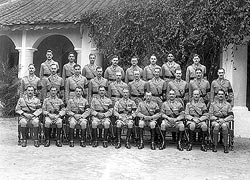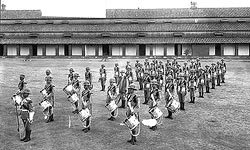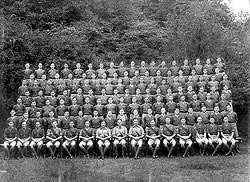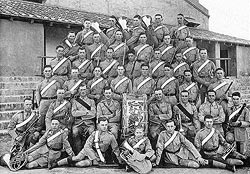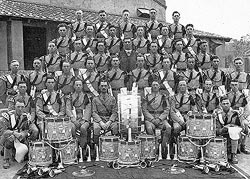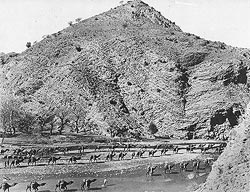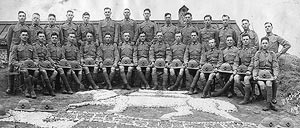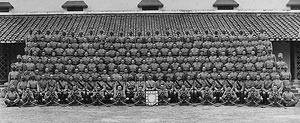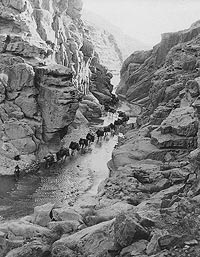Between the Wars
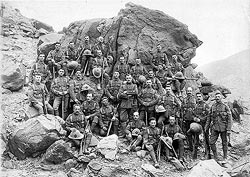 |
| The Warrant Officers and Sergeants, 2nd Bn The Queen’s Royal Regiment, Haidra Kach, North West Frontier, 1920. (Click to enlarge) |
No sooner was the war over than the situation deteriorated in North India and the return to England for demobilisation of the war-raised battalions, which had begun in 1919, was delayed. The immediate cause was the passing of the Rowlatt Acts by the Government of India which gave it very wide powers to act against persons judged guilty of sedition and caused much offence in the light of the loyal support given by the people during the war. Angry demonstrations took place throughout the Punjab, some of them involving violence against British personnel. They culminated on 13th April in the dispersal of a mob at Amritsar by Gurkha troops under the command of General Dyer. They were ordered to open fire and caused heavy civilian casualties. It had not been appreciated that the rioters had no way of dispersing from the square in which they had assembled. Then in May an Afghan army invaded the North West Frontier Province and frontier tribes rose in its support, but hostilities did not last long, a negotiated peace agreement being reached in July. In April 1/4th Queen’s manned armoured trains in the Punjab and provided other support for the civil authorities at Jullundur. Subsequently the battalion was employed in maintaining law and order in Peshawar where subversive leaflets were being circulated calling upon the Faithful to rise against the Infidels. 1/6th Surreys was similarly engaged at Agra. Eventually both battalions were able to leave India in October by which time a Regular battalion, 2nd Queen’s, had arrived from England and was stationed at Bareilly.
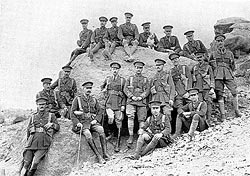 |
| 2nd Bn The Queen’s Royal Regiment Officer’s at Haidari Kach, North West Frontier 1920. (Click to enlarge) |
There was no easing of the political situation. Nationalist confidence that India would be given home rule was founded on a British Government policy statement in 1917 that there would be gradual development of self-governing institutions. It was shattered in 1919 by the Rowlatt Acts, by the widespread British support for General Dyer who claimed that had he not acted as he did at Amritsar, the Punjab would have been swept by ungovernable violence; and subsequently by delay in introducing the new constitution and disappointment at the terms of it. In 1921 Ghandi initiated his non co-operation campaign and in 1930 his more positive civil disobedience campaign when Dominion status was offered and rejected by the new young leaders of Congress Jawaharlal Nehru and Subhas Bose. In doing so he reasserted his dominance over Indian opinion and contained Congress ambitions, but the campaigns did not sustain interest, apathy returned and Muslims became convinced that the Hindu flavour of the movement was not for them. The Indian Army kept out of politics and was effective in support of the police in the maintenance of law and order.
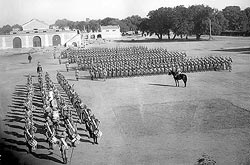 |
| 1st Bn The East Surrey Regiment, Lahore, 1st January 1934. (Click to enlarge) |
2nd Queen’s had been permitted to remain in England for the Victory Parade on 18th July 1919 and embarked for India on 7th August. At Bareilly on 6th November they were inspected by the Commander-in-Chief, General Sir Charles Munro, an old Queen’s officer, and Colonel of the Regiment.
On Christmas Day the battalion was ordered to mobilize for operations in Waziristan where it was intended to mount punitive operations against the Tochi Wazir and Mahsud tribes. However after the first phase, which did not involve the Queen’s, the tribes accepted the British terms.
The battalion did not leave Bareilly until the following year when it moved by rail to Tank for operations against the Wana Wazirs who had taken to attacking frontier posts. It was then involved in frontier operations in Waziristan throughout 1921 only arriving back at its new station in India at Lucknow on Christmas Eve.
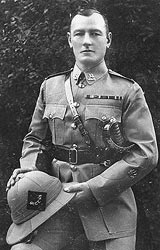 |
| RSM G Sullivan MSM. - RSM 2nd Bn The Queen's Royal Regiment. (Click to enlarge) |
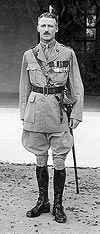 |
| Lt Col G R P Roupell VC at Fyzabad near Lahore, now called Faisalabad Commanding Officer 1st Bn The East Surrey Regiment 1935 - 1939. (Click to enlarge) |
The remainder of 2nd Queen’s tour of India was comparatively uneventful. On 14th February 1922 the battalion lined the streets in Delhi for the visit of HRH The Prince of Wales, and again at Lucknow in 1923 for a visit of the Viceroy.
In December 1923 it moved to Allahabad. In 1924 Indian officers arrived on attachment. They had received the King’s commission after passing out from Sandhurst. After the war ten places a year were reserved at Sandhurst for Indians. They were attached to British regiments for a year before joining the Indian Army. Previously King’s commissions and the mandatory attachment had been restricted to British officers before they joined their Indian regiments. In December 1926 the battalion embarked at Bombay for the Sudan after a sixty hour rail journey across India.
1st Surreys arrived at Rawalpindi from Hong Kong in November 1926. In 1927 they took part in a review by the Viceroy. In 1931 they moved to Lahore where they provided a guard of honour during a visit by the Viceroy. In 1933 they won the All India Boxing Championships. In 1934 they moved to Fyzabad which they found to be a considerably more congenial station after the ever-present tensions of Lahore. In October 1937 the battalion departed for Khartoum.
1st Queen’s arrived at Quetta from Tientsin in 1935 having left England in 1927 and served successively in Hong Kong, Malta and China. Quetta was a large garrison, 6,000 feet up in the hills and bitterly cold in winter. The Battalion moved to Allahabad in 1937 and in March 1938 one company was detached to Benares where there was Hindu-Moslem rioting. During the summer of 1939 life went on much as usual with the normal sequence of hot weather routine, hill stations and leave until the beginning of September, still very hot in Allahabad, when the calm was broken with the declaration of war on Germany.
Officers 1st Bn East Surrey Regiment, Fyzabad U P 1935. G L A Lett, Moti Segar, Methurill, Lloyd, Kealey, Tarr, Daralyinpal Singh, Edwards, Middle row: L to R: Cunnigham, Hill, Bruce,Whitehead, Thompson, Davis, Bird, Newton, Appleyard, W Anderson,, Front row seated L to R:- Doyle, Allfree, Boxshall, Voisin, Roupell VC, Armstrong, Kennedy, Ellis, Porch. This photo is taken from an album in the museum archives, sadly it does not record all ranks, initials and decorations. However a number of those present went on to very distinguished careers, G L A Lett was awarded the DSO for gallantry in Italy fighting with the partisans. R A Boxshall, a First World War officer retired as a Brigadier. D J Allfree and F O Voisin retired as Lt Cols. C D Armstrong also retired as a Lt Col having been decorated with the DSO, OBE and MC. Brigadier G R P Roupell VC retired as a Brigadier and was the last Colonel of The East Surrey Regiment. P G E Hill retired as a Major. He was for many years Regimental Secretary of The Queen’s Surrey Regimental Association and Editor of the Newsletter. He was a Trustee of the museum and he is an authority on The East Surrey Regiment and its history. |
|
1st Bn The East Surrey Regiment Corps of Drums |
Corps of Drums, 1st Bn The East Surrey Regiment, |
The Band, 1st Bn The East Surrey Regiment, |
|
Corps of Drums, 1st Bn The East Surrey Regiment, |
Ahnai Tangi, Waziristan 1921. |
No. 4 Platoon 2nd Bn The Queen's Royal Regiment. |
D, (S) Company 1st Bn The East Surrey Regiment.
Fyzabad, 1937.
(Click to enlarge)
Shahur Tangi, Waziristan 1921.
(Click to enlarge)
